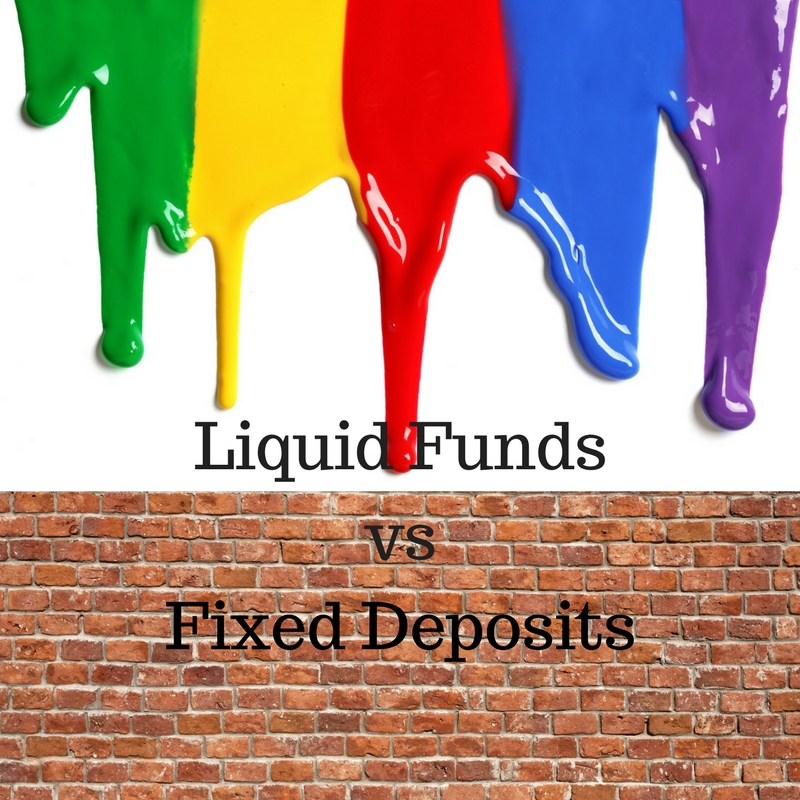Liquid Funds vs Fixed Deposit: Real Life Scenario
- 7 March 2017 | 1128 Views | By Mint2Save

If you want to earn better returns or want to save money, people often opt for fixed deposits, considering them to be relatively risk free or safe. A fixed deposit or FDs are the usual financial tool provided or offered by banks. Fixed deposits provide investors with a higher rate of interest than a regular savings account, until the given maturity date. The level of liquidity is very low. FDs offer higher rates of interest than saving accounts, as to compensate for the low liquidity. The longest allowable term for FDs is 10 years.
Liquid fund is a kind of mutual fund which invests first and foremost in money market instruments, like treasury bills, certificate of deposits, commercial papers, term deposits and other money market instruments. They let investors invest their funds for a few days or months or to earn maximum returns for the holding period as they have maturities up to 91 days. Liquid fund returns can rise or fall depending upon the market rates.
Both liquid funds with fixed deposits differ from each other in many ways. Liquid funds are easily accessible and offer the better liquidity as compared to bank fixed deposits (FDs). You need to pay the penalty for pre-mature withdrawal of your FDs. While the rate of interest offered on fixed deposits are pre-specified and fixed for the entire tenure, the returns on liquid mutual funds may differ based on the market movement. But during positive market conditions, mutual funds offer you the benefit of market-linked returns even during positive market conditions, mutual funds likely to earn high returns in the form of capital appreciation. On the other side, even if markets turned negative or positive, FDs would continue to offer you the same interest rates.
Taking in consideration the rate of inflation, inflation eats a major chunk of our savings in terms of loss in the value of money. Your investments would be creditable only if they offer you decent Inflation-adjusted returns. Assume that you have invested in a FD offering interest @ 8% p.a. while the rate of inflation is 7%; your inflation-adjusted return would be only 1%. Mutual funds have the ability to offer you better inflation-adjusted returns. But they come with a relatively higher risk. Whereas bank fixed deposits hold low risk, liquid mutual funds carry market risk which is higher than fixed deposits. So it is important to consider your risk appetite while choosing an option between bank’s fixed deposits and mutual funds. Also, be familiar with that High Return comes with High Risk.
If we talk in terms of liquidity, fixed deposits offer medium to low liquidity option and deposits come with a fixed tenure until you complete the entire tenure of the deposit. On the other side most mutual funds do offer liquidity to its investors but with definite conditions. As we mentioned earlier, you need to pay a penalty for pre-mature withdrawal of your fixed deposits, On the other hand, liquid mutual funds offer its investors, high liquidity, once the minimum holding period is complete. A liquid fund can make use of opportunities in the fixed income market to make additional returns. Savings bank accounts cannot do so.
Tax is an important feature which should be considered while choosing between liquid funds and fixed deposits. After recent dividend distribution tax changes, there is an occurrence of growth option in liquid funds if you are in the 10 and 20 percent tax slabs. Go for Daily Dividend Reinvest option if you fall in 30% tax slab. Liquid funds do not have any lock-in period. The Withdrawals from liquid funds are generally processed within 24 hours on business days. The finish time of withdrawal is usually 2 p.m. on normal business days. Thus, it means if you lay a redemption request by 2 p.m. on a business day, then the funds will be credited to your bank account on the next business day by 10 a.m. To invest in liquid fund is more beneficial in your portfolio.
When you have to decide whether you wish to choose a liquid fund or fixed deposit, keep the fund’s risk-return profile in mind. If we talk about Liquid funds this is the secure or safe option for investors from the point of view of instability and risk of losing the capital, it is important to invest in them for the right time horizon so that one doesn’t suffer from opportunity loss.









